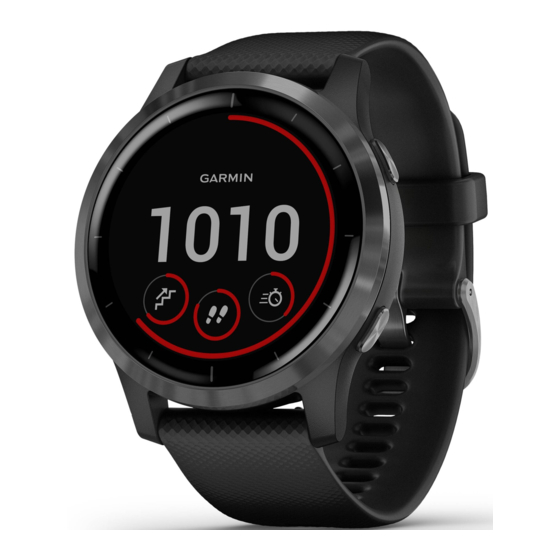Garmin Vivoactive 4S Manual del usuario - Página 14
Navegue en línea o descargue pdf Manual del usuario para Ver Garmin Vivoactive 4S. Garmin Vivoactive 4S 38 páginas.
También para Garmin Vivoactive 4S: Manual del usuario (29 páginas)

VO2 max. data is provided by FirstBeat. VO2 max.
analysis is provided with permission from The Cooper
Institute
. For more information, see the appendix
®
(VO2 Max. Standard Ratings,
CooperInstitute.org.
Getting Your VO2 Max� Estimate
The device requires heart rate data and a timed, (up to
15 minutes) brisk walk or run to display your VO2 max.
estimate.
1 Hold
.
2 Select
> User Profile > VO2 Max.
If you have already recorded a brisk walk or run
outdoors, your VO2 max. estimate may appear. The
device displays the date your VO2 max. estimate
was last updated. The device updates your VO2
max. estimate each time you complete an outdoor
walk or run of 15 minutes or longer. You can
manually start a VO2 max. test to get an updated
estimate.
3 To start a VO2 max. test, swipe up, and select Test
Now.
4 Follow the on-screen instructions to get your VO2
max. estimate.
A message appears when the test is complete.
Pulse Oximeter
The Garmin device, accessories, heart rate monitor,
pulse oximeter sensor, and related data are intended
to be used only for recreational purposes and not for
medical purposes, and are not intended to diagnose,
monitor, treat, cure, or prevent any disease or
condition.
The vívoactive device has a wrist-based pulse
oximeter to gauge the saturation of oxygen in your
blood. Knowing your oxygen saturation can help you
determine how your body is adapting to exercise and
stress. Your device gauges your blood oxygen level
by shining light into the skin and checking how much
light is absorbed. This is referred to as SpO2.
On the device, your pulse oximeter readings appear
as an SpO2 percentage. On your Garmin Connect
account, you can view additional details about your
pulse oximeter readings, including trends over multiple
days
(Changing the Pulse Oximeter Tracking Mode,
page 9). For more information on pulse oximeter
accuracy, go to garmin.com/ataccuracy.
Getting Pulse Oximeter Readings
You can manually begin a pulse oximeter reading by
viewing the pulse oximeter widget. The accuracy of the
pulse oximeter reading can vary based on your blood
flow, the device placement on your wrist, and your
stillness.
NOTE: You may need to add the pulse oximeter widget
Activity Tracking
page 31), and go to
www.
WARNING
to the widget loop.
1 While you are sitting or inactive, swipe up or down
to view the pulse oximeter widget.
2 Hold the arm wearing the device at heart level
while the device reads your blood oxygen
saturation.
3 Keep still.
The device displays your oxygen saturation as a
percentage, and a graph of your pulse oximeter
readings and heart rate values for the last four
hours.
Changing the Pulse Oximeter Tracking Mode
You can manually begin a pulse oximeter reading by
viewing the pulse oximeter widget.
1 Hold
.
2 Select
> Wrist Heart Rate > Pulse Ox > Tracking
Mode.
3 Select an option:
• To turn on measurements while you are inactive
during the day, select All Day.
NOTE: Turning on all-day tracking mode
decreases battery life.
• To turn on continuous measurements while you
sleep, select During Sleep.
NOTE: Unusual sleep positions can cause
abnormally low sleep-time SpO2 readings.
• To turn off automatic measurements, select Off.
Tips for Erratic Pulse Oximeter Data
If the pulse oximeter data is erratic or does not appear,
you can try these tips.
y Remain motionless while the device reads your
blood oxygen saturation.
y Wear the device above your wrist bone. The device
should be snug but comfortable.
y Hold the arm wearing the device at heart level
while the device reads your blood oxygen
saturation.
y Use a silicone band.
y Clean and dry your arm before putting on the
device.
y Avoid wearing sunscreen, lotion, and insect
repellent under the device.
y Avoid scratching the optical sensor on the back of
the device.
y Rinse the device with fresh water after each
workout.
Activity Tracking
The activity tracking feature records your daily step
count, distance traveled, intensity minutes, floors
climbed, calories burned, and sleep statistics for each
recorded day. Your calories burned includes your base
metabolism plus activity calories.
9
